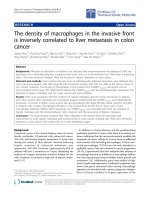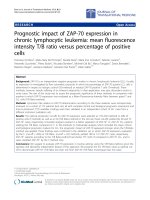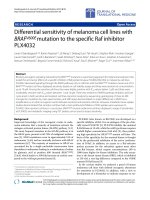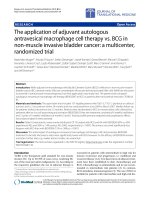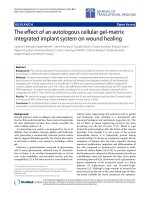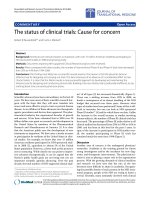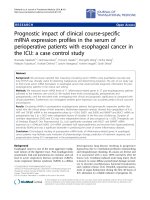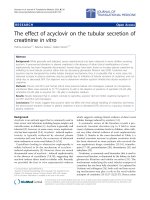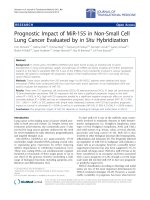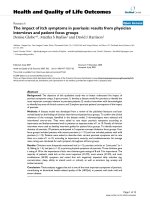báo cáo hóa học:" The impact of regular physical activity on fatigue, depression and quality of life in persons with multiple sclerosis" pdf
Bạn đang xem bản rút gọn của tài liệu. Xem và tải ngay bản đầy đủ của tài liệu tại đây (434.96 KB, 10 trang )
BioMed Central
Page 1 of 10
(page number not for citation purposes)
Health and Quality of Life Outcomes
Open Access
Research
The impact of regular physical activity on fatigue, depression and
quality of life in persons with multiple sclerosis
Nicole M Stroud* and Clare L Minahan
Address: School of Physiotherapy and Exercise Science, Gold Coast Campus, Griffith University, Queensland, Australia
Email: Nicole M Stroud* - ; Clare L Minahan -
* Corresponding author
Abstract
Background: The purpose of this study was to compare fatigue, depression and quality of life
scores in persons with multiple sclerosis who do (Exercisers) and do not (Non-exercisers)
regularly participate in physical activity.
Methods: A cross-sectional questionnaire study of 121 patients with MS (age 25–65 yr) living in
Queensland, Australia was conducted. Physical activity level, depression, fatigue and quality of life
were assessed using the International Physical Activity Questionnaire, Health Status Questionnaire
Short Form 36, Becks Depression Inventory and Modified Fatigue Impact Scale.
Results: 52 participants performed at least two 30-min exercise sessions·wk
-1
(Exercisers) and 69
did not participate in regular physical activity (Non-exercisers). Exercisers reported favourable
fatigue, depression and quality of life scores when compared to Non-exercisers. Significant weak
correlations were found between both leisure-time and overall reported physical activity levels and
some subscales of the quality of life and fatigue questionnaires. Additionally, some quality of life
subscale scores indicated that regular physical activity had a greater benefit in subjects with
moderate MS.
Conclusion: Favourable fatigue, depression and quality of life scores were reported by persons
with MS who regularly participated in physical activity, when compared to persons with MS who
were classified as Non-exercisers.
Background
Multiple Sclerosis (MS) is a relapsing or progressive neu-
rological disease with an unknown etiology and only par-
tially effective treatment. MS can have a negative impact
on both physical and psychological well being [1,2], and
individuals with this disease often report lower quality of
life (QoL) scores than when compared to healthy individ-
uals [1]. Fatigue and depression levels are higher in MS
patients than healthy individuals, and these conditions
may negatively impact upon QoL. However, participation
in regular physical activity has been suggested to posi-
tively influence feelings of fatigue [3,4] and depression
[5], as well as modify QoL [6,7] in persons with MS.
Fatigue is the most common symptom reported by per-
sons with MS [1,8], and has been negatively associated
with QoL scores [9]. The Multiple Sclerosis Council for
Clinical Practice Guidelines defines fatigue as "A subjective
lack of physical and/or mental energy that is perceived by the
individual or caregiver to interfere with usual and desired activ-
Published: 20 July 2009
Health and Quality of Life Outcomes 2009, 7:68 doi:10.1186/1477-7525-7-68
Received: 27 March 2009
Accepted: 20 July 2009
This article is available from: />© 2009 Stroud and Minahan; licensee BioMed Central Ltd.
This is an Open Access article distributed under the terms of the Creative Commons Attribution License ( />),
which permits unrestricted use, distribution, and reproduction in any medium, provided the original work is properly cited.
Health and Quality of Life Outcomes 2009, 7:68 />Page 2 of 10
(page number not for citation purposes)
ities" [10]. The pathophysiological basis of fatigue in MS
is complex and its precise mechanisms unresolved.
Fatigue in MS may result from primary factors, related to
the disease process itself, or may be secondary due to fac-
tors such as sleep disturbance and depression [10].
Fatigue may be acute or chronic in nature. Chronic fatigue
is persistent, defined as being present for any amount of
time, on 50 percent of days for at least 6 weeks[10]. Acute
fatigue is defined as new or a significant increase in fatigue
in the previous 6 weeks[10]. Some persons with MS may
also experience fatigability, where they may become
exhausted after completing a period of physical activity
[8]. Patients may also experience motor fatigue following
a period of physical activity which may lead to symptom
exacerbations [11], for example although not present at
rest a subject may develop footdrop following a period of
physical activity. This symptom exacerbation is temporary
and will subside with a rest period [12]. Considering the
symptoms, it is reasonable to suggest that fatigue, fatiga-
bility and symptom exacerbations deter individuals with
MS from participating in physical activity. Nevertheless,
studies have reported decreased fatigue levels in persons
with MS following participation in regular physical activ-
ity [3,13]. A decrease in the level of chronic fatigue and the
ability to tolerate higher levels of activity (reduced fatiga-
bility) following a program of regular exercise might lead
to improvements in QoL in persons with MS.
Depression is commonly observed in persons with MS,
[14,15] and has been negatively associated with QoL
scores [16,17]. Participation in regular physical activity is
a potential moderator of depression. Cross-sectional anal-
yses in non-MS populations suggest that individuals who
participate in regular exercise are less likely to suffer from
depression [18]. If regular physical activity also positively
influences depression in persons with MS, then it follows
that associated improvements in QoL may be observed.
The present study compared fatigue, depression and QoL
scores in persons with MS who did and did not regularly
participate in physical activity. It was hypothesised that
persons with MS who participated in regular physical
activity would report favourable fatigue, depression and
QoL scores when compared to those with MS who were
classified as Non-exercisers.
Materials and methods
Participants
A postal survey of adult men and women aged 18–65 yr
diagnosed with MS was conducted over a 6-month period.
Participants were volunteers who responded to a "call for
participants" mail-out sent to patients from two local
databases. Three hundred randomly selected patients
from a total of approximately 1000 individuals living in
South-East Queensland, Australia listed on the Multiple
Sclerosis Society of Queensland's patient database, and
118 MS patients listed on a database at the Gold Coast
Hospital, Queensland, Australia were asked to participate.
Of the 418 individuals invited to participate, 130 individ-
uals (31%) returned the questionnaires. Seven returned
questionnaires were not included due to incomplete
responses and two subjects were excluded as activity levels
reported were not representative of the subjects' usual
activity levels. Therefore, the responses of 23 men and 98
women with MS were included in the results of this study.
Procedures
The Human Ethics Research Committee, Griffith Univer-
sity, Queensland, Australia granted ethical approval for
this study. A background information questionnaire pro-
vided information on demographic and disease character-
istics including: sex, age, year of MS diagnosis and disease
course. The Disease Steps Scale (DSS) and Multiple Scle-
rosis Impact Scale (MSIS-29) assessed disease severity. The
DSS is an ordinal scale that asked the subjects to indicate
what characteristics best represented their situation. A
score of 0 = normal; 1 = mild disability, mild symptoms
or signs; 2 = moderate disability, visible abnormality of
gait; 3 = early cane, intermittent use of a cane; 4 = late
cane, cane dependant; 5 = bilateral support; 6 = confined
to a wheelchair. Although the DSS is a self administered
questionnaire, it has been found to correlate significantly
(r = 0.944) with the Expanded Disability Status Score (a
neurologist assessed measure of disease severity) and is
recommended as an alternate measure of disability status
[19].
The MSIS-29 is a twenty-nine itemed questionnaire that
assesses the individual's view of how their MS has
impacted upon their daily functioning during the previ-
ous 2 weeks. Responses for each of the 29 items in the
questionnaire were scored as follows: 1 = not at all, 2 = a
little, 3 = moderately, 4 = quite a bit, 5 = extremely. The
MSIS-29 is a reliable and valid measure of disease impact,
and is suggested to be a useful and responsive outcome
measure in clinical research [20-22].
The International Physical Activity Questionnaire (IPAQ)
was used to classify subjects as either 'Exercisers' or 'Non-
exercisers'. The IPAQ quantifies physical activity per-
formed in the preceding 7 days. A total physical activity
score is derived based on total activity time and intensity,.
The total physical activity score, reported in metabolic
equivalents (MET)-min·wk
-1
, is a combination of scores
reported in four domains: transportation, work, domestic-
garden, and leisure. Subjects were classified as 'Exercisers'
if they completed at least two, 30-min exercise
sessions·wk
-1
during their leisure time or had a physical
activity score, in the leisure domain of the IPAQ, greater
than 600 MET-min·wk
-1
[23].
Health and Quality of Life Outcomes 2009, 7:68 />Page 3 of 10
(page number not for citation purposes)
The Health Status Questionnaire Short Form-36 (SF36)
assessed QoL. The SF36 is a widely used QoL measure that
provides scores for eight dimensions: physical function-
ing (limitations in physical functioning due to health
problems), role-physical (limitations in usual activities
because of physical health problems), bodily pain, gen-
eral health, vitality (energy and fatigue), social function-
ing (limitations in social functioning due to physical or
emotional problems), role-emotional (limitation in usual
activities due to emotional problems) and mental health
(psychological distress and well-being) [24]. Combining
the SF36 scales produces two summary scales: i) a physical
component summary score, and ii) a mental component
summary score; on all scales higher scores indicate a
higher QoL. The SF36 has been found to have good relia-
bility and validity in the general population [25], patients
undergoing renal replacement therapy [26] and patients
with cervical spondylotic myelopathy [27].
The Beck's Depression Inventory (BDI) assessed depres-
sion. The BDI is a twenty-one item questionnaire asking
patients how they have felt over the past 7 days. Each
question is scored between 0–3, with higher scores indi-
cating more severe depression [28]. The BDI has been
found to be a valid measure of depression in persons with
MS [29].
Fatigue was assessed using the Modified Fatigue Impact
Scale (MFIS) and provides an indication of fatigue experi-
enced by an individual in three domains; physical, cogni-
tive, and psychosocial. The independent scores can be
analysed separately or as a combined score to give a gen-
eral assessment of fatigue. Higher scores indicate that
fatigue has a greater impact on the individual. The MFIS
has been suggested as a useful measure of fatigue in MS
research and clinical practice [30].
Data analysis
Data was analysed using the statistical software package
SPSS version 14.0. Independent t-tests between subjects
classified as Exercisers and Non-exercisers were performed
for age, years since MS diagnosis, MSIS-29, BDI and each
subscale of the SF36 and MFIS. Chi-square analyses were
performed between Exercisers and Non-exercisers for sex,
disease course and disease severity. Pearson's bivariate
correlations between both the overall and leisure IPAQ
score and the BDI, and all subscales of MFIS and SF36
were performed. Univariate analysis between disease
severity, exercise status and the BDI and all subscales of
the MFIS and SF36 were conducted. Statistical significance
was accepted at p ≤ 0.05.
Results
Demographic and clinical characteristics
In this sample population, 52 of 121 (43%) subjects were
classified as Exercisers. Table 1 presents selected demo-
graphic and clinical characteristics. No significant differ-
ence in age, sex, years since MS diagnosis or disease
severity was observed between Exercisers and Non-exercis-
ers. Exercisers reported significantly lower scores on the
MSIS-29 (t = -3.99, p < .001) and disease course was sig-
nificantly different (χ
2
(4, N = 121) = 13.80, p = 0.008)
between Exercisers and Non-exercisers.
Table 1: Subject demographic and clinical characteristics
Exercisers
n = 52
Non-exercisers
n = 69
Total MS sample
n = 121
Age (yr) 50 ± 10 50 ± 11 50 ± 10
Sex (% male) 23.1 15.9 19.0
Disease duration (yr) 12 ± 8 11 ± 8 12 ± 8
Disease Steps Score (%)
0 15.4 8.7 11.6
126.924.625.6
217.313.014.9
3 5.8 11.6 9.1
419.217.418.2
511.511.611.6
6 3.8 13.0 9.1
MSIS-29 61 ± 18** 77 ± 26 70 ± 24
Disease Course (%)*
Relapsing-remitting 51.9 55.1 53.7
Secondary progressive 23.1 13.0 17.4
Primary progressive 1.9 17.4 10.7
Progressive relapsing 0.0 4.3 2.5
Unknown 23.1 10.1 15.7
Results are presented as mean ± standard deviation unless otherwise indicated. MSIS-29: Multiple Sclerosis Impact Scale-29. ** Exercisers
significantly different to Non-exercisers, p < 0.001. * Exercises significantly different to Non-exercisers, p < 0.05.
Health and Quality of Life Outcomes 2009, 7:68 />Page 4 of 10
(page number not for citation purposes)
Fatigue, depression and quality of life scores
Exercisers had significantly higher scores on all scales of
the SF36 when compared to Non-exercisers (Figure 1).
The BDI (Figure 2), as well as the Physical and Psychoso-
cial components, and overall score of the MFIS (Figure 3)
were significantly lower in the Exercisers. There was no
significant difference between Exercisers and Non-exercis-
ers on the cognitive component of the MFIS.
The impact of disease severity on fatigue, depression and
quality of life
Univariate analysis of variance between disease severity,
exercise status and depression, fatigue and QoL scores in
persons with MS found main effects for exercise status and
disease severity in some QoL and fatigue scores (Table 2).
There was an interaction effect for the Physical Function,
Bodily Pain and Physical Component Summary Score of
the SF36 (Figures 4, 5 and 6).
The influence of the quantity of regular physical activity
on fatigue, depression and quality of life scores
Significant but weak correlations between the leisure-time
activity subscale of the IPAQ and the Physical Role(r =
0.214) and General Health (r = 0.254) subscales of the
SF36, and the Physical (r = -0.220) and Psychosocial (r =
-0.246) scales of the MFIS were detected. When overall
activity levels were analysed, there were significant corre-
lations between the overall score of the IPAQ and the
Physical Function (r = 0.409), Physical Role (r = 0.234),
Vitality (r = 0.198) and Physical Component Summary
Score (r = 0.312) of the SF36 and the Physical (r = -0.250)
and Psychosocial (r = -0.257) scales of the MFIS.
Discussion
The purpose of this study was to compare fatigue, depres-
sion and QoL scores in persons with MS who did and did
not participate in regular physical activity. A recent review
of exercise intervention studies in persons with MS, found
Quality of life scores in people with multiple sclerosisFigure 1
Quality of life scores in people with multiple sclerosis. Error bars represent standard deviations. Higher scores repre-
sent more favourable perceived quality of life. Exercisers represent individuals who reported participating in at least two, 30-
min exercise sessions·wk
-1
, or had a physical activity score in the leisure domain of the International Physical Activity Question-
naire greater than 600 MET-min·wk
-1
. * Exercisers significantly different from non-exercisers, p < 0.05. ** Exercisers signifi-
cantly different from Non-exercisers, p < 0.001.
Health and Quality of Life Outcomes 2009, 7:68 />Page 5 of 10
(page number not for citation purposes)
evidence to support the positive effect of exercise on QoL,
however these authors concluded their was insufficient
research in this area [31]. The findings of this study sup-
port the hypothesis that regular physical activity is associ-
ated with favourable fatigue, depression and QoL scores
in persons with MS.
In the present study, subjects classified as Exercisers
reported less fatigue on the Physical and Psychosocial
scales and overall score of the MFIS. These results are sup-
ported by Trojan et al (2007) who preformed correlation
analysis on the General, Mental and Physical scales of the
Multidimensional Fatigue Inventory and found that phys-
ical activity was weakly correlated with the Physical but
not the General or Mental scales of the Multidimensional
Fatigue Inventory [32].
Fatigue in MS may be attributed to primary factors related
to the disease process or secondary factors such as sleep
disturbances, depression, pain and medication use [33].
Theories of primary fatigue in MS include hypo-function-
ing within the central nervous system [34], reduced glu-
cose metabolism in the cortical regions of the brain [35],
reduced inhibition of the primary motor cortex in the pre-
and post- exercise period [36] and abnormal cytokine pro-
files [37,38]. Both aerobic- and resistance-based exercise
programs have been found to alter cytokine profiles in MS
patients [39,40] and this provides a plausible explanation
Depression scores in people with multiple sclerosisFigure 2
Depression scores in people with multiple sclerosis.
Error bars represent standard deviations. Higher scores rep-
resent greater depression levels. Exercisers represent indi-
viduals who reported participating in at least two, 30-min
exercise sessions·wk
-1
, or had a physical activity score in the
leisure domain of the International Physical Activity Ques-
tionnaire greater than 600 MET-min·wk
-1
. ** Exercisers sig-
nificantly different from Non-exercisers, p < 0.001.
Fatigue scores in people with multiple sclerosisFigure 3
Fatigue scores in people with multiple sclerosis. Error
bars represent standard deviations. Higher scores represent
greater fatigue levels. Exercisers represent individuals who
reported participating in at least two, 30-min exercise
sessions·wk
-1
, or had a physical activity score in the leisure
domain of the International Physical Activity Questionnaire
greater than 600 MET-min·wk
-1
. * Exercisers significantly dif-
ferent from non-exercisers, p < 0.05. ** Exercisers signifi-
cantly different from Non-exercisers, p < 0.001.
Health Status Questionnaire Short Form-36 Physical Compo-nent Summary Score across disease severity in people with multiple sclerosisFigure 4
Health Status Questionnaire Short Form-36 Physical
Component Summary Score across disease severity
in people with multiple sclerosis. Error bars represent
standard deviations. Higher scores represent more favoura-
ble perceived quality of life. Exercisers represent individuals
who reported participating in at least two, 30-min exercise
sessions·wk
-1
, or had a physical activity score in the leisure
domain of the International Physical Activity Questionnaire
greater than 600 MET-min·wk
-1
.
Health and Quality of Life Outcomes 2009, 7:68 />Page 6 of 10
(page number not for citation purposes)
Table 2: Univariate analysis of exercise status, disease severity and quality of life, depression and fatigue scores
BDI SF36PF SF36RP SF36BP SFGH
Exercise Status 5.632* 12.983** 1.236 2.149 9.325**
Disease Severity 1.159 39.953** 10.437** 4.921** 2.810*
Interaction effect 0.822 2.527* 0.988 2.754* 2.004
SF36VT SF36SF SF36RE SF36MH SF36PCSS
Exercise Status 5.631* 7.440** 3.074 7.398** 5.532*
Disease Severity 3.752** 1.527 0.791 0.839 23.693**
Interaction effect 1.191 0.406 0.430 0.450 2.314*
SF36MCSS MFISphy MFIScog MFISpsy MFIStot
Exercise Status 5.436* 9.247** 1.153 4.547** 1.549
Disease Severity 0.671 10.624** 3.986** 10.489** 7.160**
Interaction effect 0.202 0.707 1.813 0.486 0.413
Values represent F score of a univariate analysis of variance. BDI: Becks Depression Inventory, SF36: Health Status Questionnaire Short Form-36,
PF: physical function, RP: physical role, BP: bodily pain, GH: general health, VT: vitality, SF: social functioning, RE: emotional role, MH: mental health,
PCSS: physical component summary score, MCSS: mental component summary score, MFISphy: Modified Fatigue Impact Scale physical component,
MFIScog: Modified Fatigue Impact Scale cognitive component, MFISpsy: Modified Fatigue Impact Scale psychosocial component, MFIStot: Modified
Fatigue Impact Scale overall score. IPAQleisure: International Physical
Health Status Questionnaire Short Form-36 Physical Func-tion Component Score across disease severity in people with multiple sclerosisFigure 5
Health Status Questionnaire Short Form-36 Physical
Function Component Score across disease severity in
people with multiple sclerosis. Error bars represent
standard deviations. Higher scores represent more favoura-
ble perceived quality of life. Exercisers represent individuals
who reported participating in at least two, 30-min exercise
sessions·wk
-1
, or had a physical activity score in the leisure
domain of the International Physical Activity Questionnaire
greater than 600 MET-min·wk
-1
.
Health Status Questionnaire Short Form-36 Bodily Pain Component Score across disease severity in people with multiple sclerosisFigure 6
Health Status Questionnaire Short Form-36 Bodily
Pain Component Score across disease severity in
people with multiple sclerosis. Error bars represent
standard deviations. Higher scores represent more favoura-
ble perceived quality of life. Exercisers represent individuals
who reported participating in at least two, 30-min exercise
sessions·wk
-1
, or had a physical activity score in the leisure
domain of the International Physical Activity Questionnaire
greater than 600 MET-min·wk
-1
.
Health and Quality of Life Outcomes 2009, 7:68 />Page 7 of 10
(page number not for citation purposes)
for the improvement in fatigue seen in some patients fol-
lowing regular physical activity.
Alternatively, improvements in secondary factors such as
depression with regular physical activity may explain the
improvements seen in fatigue in some MS patients.
Depression scores observed in the Exercisers in the present
study were significantly lower when compared to Non-
exercisers. It is well recognised that exercise is positively
associated with psychological well being in the general
population [41-45]. It is unclear exactly how exercise
improves depression in non-MS populations, however
several theories have been proposed including: regulation
of the hypothalamic-pituitary axis [46], increased β-
endorphin levels [46], normalisation of hippocampal
brain derived neurotrophic factor [47], regulation of cen-
tral monoamines [46] and improved perceptions of self
efficacy [48]. The hypothalamic-pituitary axis [49], brain-
derived neurotrophic factor [50] and serotonin [51] have
all been implicated in MS pathology. If exercise influences
hypothalamic-pituitary axis function, brain-derived neu-
rotrophic factor concentration or serotonin concentration
in persons with MS, this provides a possible explanation
for the decreased incidence of depression observed in per-
sons with MS who regularly participate in physical activ-
ity. Alternatively, depression etiology in MS may have a
psychological rather than neurobiological explanation. In
persons with MS, a positive relationship between activity
levels and self-efficacy has been reported [52]. Due to the
relatively high incidence of depression in MS, both the eti-
ology and the influence of exercise on depression are areas
that warrant further investigation.
In the present study, Exercisers had significantly higher
scores on all components of the SF-36, which is suggestive
of a higher QoL. These findings are supported by Stuifber-
gen et al (2006) who found that exercise behaviour, meas-
ured using the exercise/physical subscale of the Health
Promoting Lifestyle Profile II, was positively associated
with QoL[7]. When QoL was assessed across the spectrum
of disease severity, we found interaction effects between
exercise status and disease severity for the Physical Func-
tion, Bodily Pain and Physical Component Summary
Scores of the SF36 (Figures 4, 5 and 6). Visual interpreta-
tion of these figures suggests that although these scales
were similar between Exercisers and Non-exercisers with
mild MS (DSS ≤1), regular physical activity impacts
favourably upon QoL in patients with a DSS between two
and four. Once disease severity reached a DSS ≥5, QoL
was again similar between Exercisers and Non-exercisers.
Therefore, participation in regular physical activity
appears to have the greatest positive influence on QoL in
patients once visual abnormalities in gait have developed,
until the point of time when patients become cane-
dependant.
To date the majority of exercise intervention studies have
focused on patients with mild-moderate MS, and
although these studies have been associated with positive
benefits for persons with MS [53,54], little information is
available on the influence of physical activity for persons
across the disease spectrum. The results of this study sug-
gest the exercise may have a greater effect on QoL in the
physical domain in persons with moderate MS. The rea-
son for this is unknown, however it may be speculated
that regular physical activity improves a patients' ability to
perform physical tasks, or improves a patients' perception
of the impact their disability has on their physical func-
tioning. This improved QoL in the physical function, and
physical component summary scores of the SF36, may be
particularly evident in patients with moderate MS. Per-
haps in persons with mild MS, the physical limitations of
the disease are minimal and therefore irrespective of exer-
cise status the impact of the disease on QoL in the physical
domain is minimal. Similarly, it maybe once disease
severity and physical limitation become severe, that these
limitations will significantly impact on QoL irrespective
of exercise status. This is an area that warrants further
investigation, in order for health care professionals to
implement exercise intervention and management pro-
grams to those patients who will receive maximal benefit.
Cross-sectional studies investigating the role of physical
activity on QoL in persons with MS have typically corre-
lated activity levels and QoL scores [7,55]. The present
study reported significant weak correlations between both
leisure and overall activity scores on the IPAQ, and some
fatigue, depression and QoL scores in persons with MS.
This suggests that there may not be a linear relationship
between activity levels and fatigue, depression and QoL
scores in persons with MS.
The current study classified Exercisers as subjects who
completed at least two 30-min exercise sessions·wk
-1
.
This exercise volume does not meet the recommended
dose of exercise prescribed by the American College of
Sports Medicine [56]. It is unknown whether the comple-
tion of two 30-min exercise sessions·wk
-1
would elicit
adaptations in cardiovascular fitness or reduce the risk of
co-morbidities and unhealthy weight gain in this clinical
population. However, the current study does suggest that
completing at least two 30-min exercise sessions·wk
-1
may positively influence disease specific symptoms such
as fatigue and depression in persons with MS.
Due to the cross-sectional nature of this study we cannot
provide definitive conclusions on the direction of causal-
ity between activity levels and fatigue, depression and
QoL scores. Subjects in this study were recruited from two
separate patient databases. Although we have no reason to
believe there would be any differences in the disease char-
Health and Quality of Life Outcomes 2009, 7:68 />Page 8 of 10
(page number not for citation purposes)
acteristics of the patients in the two databases utilised in
this study we did not perform any analysis to confirm this.
Data was collected in a de-identified manner and we were
unable to provide information on responders vs. non-
responders and we cannot guarantee that the sample pop-
ulation utilised in this study provides an accurate repre-
sentation of all persons with MS living in Queensland,
Australia. This study had a reasonably low response rate
(31%) and it is possible that health conscious individuals
may have been more inclined to participate in the study.
This may be demonstrated by the relatively higher
number of Exercisers in this study (43%) compared to a
rate of 28.6% in a recent cross-sectional survey of men
with MS [57]. Additionally it is worthwhile noting that
although the sex distribution between subjects classified
as Exercisers (23% male) and Non-exercisers (17% male)
are not statistically significant, these numbers may in fact
represent a difference that may impact on the results of
this study.
Subjects recruited through the MS Society of Queensland's
database had not had their MS diagnosis confirmed by a
physician or neurologist, and disease course and severity
are patient and not physician reported, this may provide a
source of error in the patient characteristics reported. The
final limitation to consider when interpreting the results
of this study is that we found a statistically significant dif-
ference in the MSIS-29 score between Exercisers and Non-
exercisers. The MSIS-29 measures the impact of the dis-
ease on the individual of the previous 2 weeks, it is possi-
ble that regular exercise may improve the MSIS-29 by
improving either the perception or the ability of the indi-
vidual to perform physical tasks, alternately, this differ-
ence in MSIS-29 score may indicate a difference in the
baseline characteristics between the Exercisers and Non-
exercisers in this study.
The strength of the current study is that although exercise
intervention studies have been associated with improved
fatigue, depression and QoL in small samples of MS
patients, this study provides an overall view of these rela-
tionships. This study focused on patients across the entire
disease spectrum and was not limited to those with mild-
moderate MS.
Conclusion
In summary, subjects who participated in regular physical
activity reported better results on the BDI, all scales of the
SF36, and some scales of the MFIS. This suggests that per-
sons with MS who regularly participate in physical activity
have favourable fatigue, depression and QoL scores, when
compared to persons with MS who do not regularly par-
ticipate in physical activity. This study gives strength to
previous suggestions that regular physical activity may
improve fatigue, depression and QoL in persons with MS.
This study reinforces that health care providers should
promote physical activity in persons with MS as a strategy
to improve QoL. This study does highlight the need for
exercise intervention studies to occur not only in persons
with mild-moderate disability but in those patients with
moderate-severe disability as well, in order to understand
the potential for physical activity to improve QoL in all
persons with MS. Further research investigating the mode
of exercise that will provide maximum benefit to persons
with MS, across the entire disease spectrum is warranted.
Abbreviations
MS: multiple sclerosis; Exercisers: persons with MS who
regularly participate in at least two, 30 min exercise ses-
sions per week; Non-exercisers: persons with MS who do
not regularly participate in at least two, 30 min exercise
sessions per week; QoL: quality of life; DSS: Disease Steps
Scale; MSIS-29: Multiple Sclerosis Impact Scale; IPAQ:
International Physical Activity Questionnaire; MET: meta-
bolic equivalent; SF36: Heath Status Questionnaire Short
Form 36; BDI: Beck's Depression Inventory; MFIS: Modi-
fied Fatigue Impact Scale
Competing interests
The authors declare that they have no competing interests.
Authors' contributions
NS was involved in all aspects of this study. She was
involved in the concept and design, data collection and
collation, data analysis, writing and editing of the manu-
script. CM was involved in the conception and design of
the study, as well as data analysis and writing and editing
of the manuscript. Both authors read and approved the
final manuscript.
Acknowledgements
We would like to acknowledge the Multiple Sclerosis Society of Queens-
land for their assistance in the recruitment of the subjects who participated
in this study.
References
1. Khan F, McPhail T, Brand C, Turner-Stokes L, Kilpatrick T: Multiple
sclerosis: disability profile and quality of life in an Australian
community cohort. Int J Rehabil Res 2006, 29(2):87-96.
2. Gulick EE: Symptom and activities of daily living trajectory in
multiple sclerosis: a 10-year study. Nurs Res 1998,
47(3):137-146.
3. White LJ, McCoy SC, Castellano V, Gutierrez G, Stevens JE, Walter
GA, Vandenborne K: Resistance training improves strength
and functional capacity in persons with multiple sclerosis.
Mult Scler 2004, 10(6):668-674.
4. Gutierrez GM, Chow JW, Tillman MD, McCoy SC, Castellano V,
White LJ: Resistance training improves gait kinematics in per-
sons with multiple sclerosis. Arch Phys Med Rehabil 2005,
86(9):1824-1829.
5. Tesar N, Baumhackl U, Kopp M, Gunther V: Effects of psycholog-
ical group therapy in patients with multiple sclerosis. Acta
Neurol Scand 2003, 107(6):394-399.
6. Motl RW, McAuley E, Snook EM: Physical activity and multiple
sclerosis: a meta-analysis. Mult Scler 2005, 11(4):459-463.
Health and Quality of Life Outcomes 2009, 7:68 />Page 9 of 10
(page number not for citation purposes)
7. Stuifbergen AK, Blozis SA, Harrison TC, Becker HA: Exercise, func-
tional limitations, and quality of life: a longitudinal study of
persons with multiple sclerosis. Arch Phys Med Rehabil 2006,
87(7):935-943.
8. Iriarte J, Subira ML, Castro P: Modalities of fatigue in multiple
sclerosis: correlation with clinical and biological factors. Mult
Scler 2000, 6(2):124-130.
9. Turpin KV, Carroll LJ, Cassidy JD, Hader WJ: Deterioration in the
health-related quality of life of persons with multiple sclero-
sis: the possible warning signs. Mult Scler 2007, 13(8):1038-1045.
10. Multiple Sclerosis Council for Clinical Practice Guidelines: Fatigue
and multiple sclerosis: evidence-based management strate-
gies for fatigue in multiple sclerosis. Paralyzed Veterans of Amer-
ica 1998.
11. Petajan JH, White AT: Motor-evoked potentials in response to
fatiguing grip exercise in multiple sclerosis patients. Clin Neu-
rophysiol 2000, 111(12):2188-2195.
12. Smith RM, Adeney-Steel M, Fulcher G, Longley WA: Symptom
change with exercise is a temporary phenomenon for people
with multiple sclerosis. Arch Phys Med Rehabil 2006,
87(5):723-727.
13. Roehrs T, Karst G: Effects of an aquatics exercise program on
quality of life measures for individuals with progressive mul-
tiple sclerosis. Journal of Neurologic Physical Therapy 2004, 28(2):63.
14. Beiske AG, Svensson E, Sandanger I, Czujko B, Pedersen ED, Aarseth
JH, Myhr KM: Depression and anxiety amongst multiple scle-
rosis patients. Eur J Neurol 2008, 15(3):239-45.
15. Sollom AC, Kneebone II: Treatment of depression in people
who have multiple sclerosis. Mult Scler 2007, 13(5):632-635.
16. Janardhan V, Bakshi R: Quality of life in patients with multiple
sclerosis: the impact of fatigue and depression. J Neurol Sci
2002, 205(1):51-58.
17. Lobentanz IS, Asenbaum S, Vass K, Sauter C, Klosch G, Kollegger H,
Kristoferitsch W, Zeitlhofer J: Factors influencing quality of life
in multiple sclerosis patients: disability, depressive mood,
fatigue and sleep quality. Acta Neurol Scand 2004, 110(1):6-13.
18. Harris AH, Cronkite R, Moos R: Physical activity, exercise cop-
ing, and depression in a 10-year cohort study of depressed
patients. J Affect Disord 2006, 93(1–3):79-85.
19. Hohol MJ, Orav EJ, Weiner HL: Disease steps in multiple sclero-
sis: a longitudinal study comparing disease steps and EDSS
to evaluate disease progression. Mult Scler 1999, 5(5):349-354.
20. Hobart J, Lamping D, Fitzpatrick R, Riazi A, Thompson A: The Mul-
tiple Sclerosis Impact Scale (MSIS-29): a new patient-based
outcome measure. Brain 2001, 124(Pt 5):962-973.
21. Hoogervorst EL, Zwemmer JN, Jelles B, Polman CH, Uitdehaag BM:
Multiple Sclerosis Impact Scale (MSIS-29): relation to estab-
lished measures of impairment and disability. Mult Scler 2004,
10(5):569-574.
22. McGuigan C, Hutchinson M: The multiple sclerosis impact scale
(MSIS-29) is a reliable and sensitive measure. J Neurol Neuro-
surg Psychiatry 2004, 75(2):266-269.
23. Guidelines for data processing and analysis of the Interna-
tional Physical Activity Questionnaire (IPAQ)-short and long
forms [ />]
24. Ware JE Jr, Sherbourne CD: The MOS 36-item short-form
health survey (SF-36). I. Conceptual framework and item
selection. Med Care 1992, 30(6):473-483.
25. Brazier JE, Harper R, Jones NM, O'Cathain A, Thomas KJ, Usherwood
T, Westlake L: Validating the SF-36 health survey question-
naire: new outcome measure for primary care. BMJ 1992,
305(6846):160-164.
26. Gomez-Besteiro MI, Santiago-Perez MI, Alonso-Hernandez A, Valdes-
Canedo F, Rebollo-Alvarez P: Validity and reliability of the SF-36
questionnaire in patients on the waiting list for a kidney
transplant and transplant patients. Am J Nephrol 2004,
24(3):346-351.
27. King JT Jr, Roberts MS: Validity and reliability of the Short
Form-36 in cervical spondylotic myelopathy. J Neurosurg 2002,
97(2 Suppl):180-185.
28. Beck AT, Ward CH, Mendelson M, Mock J, Erbaugh J: An inventory
for measuring depression. Arch Gen Psychiatry 1961, 4:561-571.
29. Moran PJ, Mohr DC: The validity of Beck Depression Inventory
and Hamilton Rating Scale for Depression items in the
assessment of depression among patients with multiple scle-
rosis. J Behav Med 2005, 28(1):35-41.
30. Kos D, Kerckhofs E, Carrea I, Verza R, Ramos M, Jansa J: Evaluation
of the Modified Fatigue Impact Scale in four different Euro-
pean countries. Mult Scler 2005, 11(1):76-80.
31. Asano M, Dawes D, Arafah A, Moriello C, Mayo N: What does a
structured review of the effectiveness of exercise interven-
tions for persons with multiple sclerosis tell us about the
challenges of designing trials? Mult Scler 2009, 15(4):412-421.
32. Trojan D, Arnold D, Collet JP, Shapiro S, Bar-Or A, Robinson A, Le
Cruguel JP, Ducruet T, Narayanan S, Arcelin K, Wong AN, Tartaglia
MC, Lapierre Y, Caramanos Z, Da Costa D: Fatigue in multiple
sclerosis: association with disease-related, behavioural and
psychosocial factors. Mult Scler 2007, 13(8):985-995.
33. Kos D, Kerckhofs E, Nagels G, D'Hooghe MB, Ilsbroukx S: Origin of
fatigue in multiple sclerosis: review of the literature.
Neurore-
habil Neural Repair 2008, 22(1):91-100.
34. Filippi M, Rocca MA, Colombo B, Falini A, Codella M, Scotti G, Comi
G: Functional magnetic resonance imaging correlates of
fatigue in multiple sclerosis. Neuroimage 2002, 15(3):559-567.
35. Roelcke U, Kappos L, Lechner-Scott J, Brunnschweiler H, Huber S,
Ammann W, Plohmann A, Dellas S, Maguire RP, Missimer J, Radü EW,
Steck A, Leenders KL: Reduced glucose metabolism in the fron-
tal cortex and basal ganglia of multiple sclerosis patients
with fatigue: a 18F-fluorodeoxyglucose positron emission
tomography study. Neurology 1997, 48(6):1566-1571.
36. Liepert J, Mingers D, Heesen C, Baumer T, Weiller C: Motor cortex
excitability and fatigue in multiple sclerosis: a transcranial
magnetic stimulation study. Mult Scler 2005, 11(3):316-321.
37. Heesen C, Nawrath L, Reich C, Bauer N, Schulz KH, Gold SM:
Fatigue in multiple sclerosis: an example of cytokine medi-
ated sickness behaviour? J Neurol Neurosurg Psychiatry 2006,
77(1):34-39.
38. Flachenecker P, Bihler I, Weber F, Gottschalk M, Toyka KV, Rieck-
mann P: Cytokine mRNA expression in patients with multiple
sclerosis and fatigue. Mult Scler 2004, 10(2):165-169.
39. Heesen C, Gold SM, Hartmann S, Mladek M, Reer R, Braumann KM,
Wiedemann K, Schulz KH: Endocrine and cytokine responses to
standardized physical stress in multiple sclerosis. Brain Behav
Immun 2003, 17(6):473-481.
40. White LJ, Castellano V, Mc Coy SC: Cytokine responses to resist-
ance training in people with multiple sclerosis. J Sports Sci
2006, 24(8):911-914.
41. Hassmen P, Koivula N, Uutela A: Physical exercise and psycho-
logical well-being: a population study in Finland. Prev Med
2000, 30(1):17-25.
42. Williams P, Lord SR: Effects of group exercise on cognitive func-
tioning and mood in older women. Aust N Z J Public Health 1997,
21(1):45-52.
43. Ussher MH, Owen CG, Cook DG, Whincup PH: The relationship
between physical activity, sedentary behaviour and psycho-
logical wellbeing among adolescents. Soc Psychiatry Psychiatr Epi-
demiol 2007, 42(10):851-856.
44. Stephens T: Physical activity and mental health in the United
States and Canada: evidence from four population surveys.
Prev Med 1988, 17(1):35-47.
45. Harris AH, Cronkite R, Moos R: Physical activity, exercise cop-
ing, and depression in a 10-year cohort study of depressed
patients. J Affect Disord 2006, 93(1–3):79-85.
46. Brosse AL, Sheets ES, Lett HS, Blumenthal JA: Exercise and the
treatment of clinical depression in adults: recent findings and
future directions. Sports Med 2002, 32(12):741-760.
47. Zheng H, Liu Y, Li W, Yang B, Chen D, Wang X, Jiang Z, Wang H,
Wang Z, Cornelisson G, Halberg F: Beneficial effects of exercise
and its molecular mechanisms on depression in rats. Behav
Brain Res 2006, 168(1):47-55.
48. Bandura A: Social foundations of thought and action. A social
cognitive theory. New Jersey: Prentice-Hall Inc; 1986.
49. Fassbender K, Schmidt R, Mossner R, Kischka U, Kuhnen J, Schwartz
A, Hennerici M: Mood disorders and dysfunction of the hypoth-
alamic-pituitary-adrenal axis in multiple sclerosis: associa-
tion with cerebral inflammation. Arch Neurol 1998, 55(1):66-72.
50. Azoulay D, Vachapova V, Shihman B, Miler A, Karni A: Lower brain-
derived neurotrophic factor in serum of relapsing remitting
MS: reversal by glatiramer acetate. J Neuroimmunol 2005,
167(1–2):215-218.
Publish with BioMed Central and every
scientist can read your work free of charge
"BioMed Central will be the most significant development for
disseminating the results of biomedical research in our lifetime."
Sir Paul Nurse, Cancer Research UK
Your research papers will be:
available free of charge to the entire biomedical community
peer reviewed and published immediately upon acceptance
cited in PubMed and archived on PubMed Central
yours — you keep the copyright
Submit your manuscript here:
/>BioMedcentral
Health and Quality of Life Outcomes 2009, 7:68 />Page 10 of 10
(page number not for citation purposes)
51. Sandyk R: Serotonergic neuronal atrophy with synaptic inac-
tivation, not axonal degeneration, are the main hallmarks of
multiple sclerosis. Int J Neurosci 1998, 95(1–2):133-140.
52. Motl RW, Snook EM, McAuley E, Gliottoni RC: Symptoms, self-
efficacy, and physical activity among individuals with multi-
ple sclerosis. Res Nurs Health 2006, 29(6):597-606.
53. Barrett C, Mann G, Taylor P, Strike P: A randomized trial to
investigate the effects of functional electrical stimulation
and therapeutic exercise on walking performance for people
with multiple sclerosis. Mult Scler 2009, 15(4):493-504.
54. Dettmers C, Sulzmann M, Ruchay-Plossl A, Gutler R, Vieten M:
Endurance exercise improves walking distance in MS
patients with fatigue. Acta Neurol Scand 2009 in press.
55. Stuifbergen AK: Physical activity and perceived health status in
persons with multiple sclerosis. J Neurosci Nurs 1997,
29(4):238-243.
56. Haskell WL, Lee IM, Pate RR, Powell KE, Blair SN, Franklin BA, Mac-
era CA, Heath GW, Thompson PD, Bauman A: Physical activity
and public health: updated recommendation for adults from
the American College of Sports Medicine and the American
Heart Association. Circulation 2007, 116(9):1081-1093.
57. Turner AP, Kivlahan DR, Haselkorn JK: Exercise and quality of life
among people with multiple sclerosis: looking beyond physi-
cal functioning to mental health and participation in life. Arch
Phys Med Rehabil 2009, 90(3):420-428.
